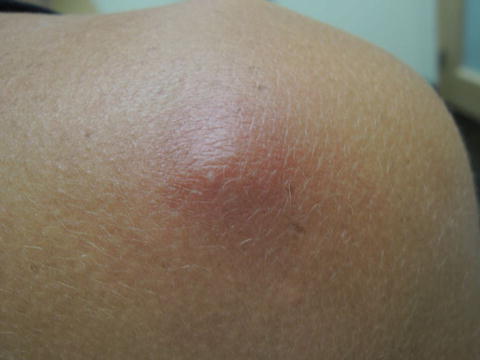, Corinna Eleni Psomadakis2 and Bobby Buka3
(1)
Department of Family Medicine, Mount Sinai School of Medicine Attending Mount Sinai Doctors/Beth Israel Medical Group-Williamsburg, Brooklyn, NY, USA
(2)
School of Medicine Imperial College London, London, UK
(3)
Department of Dermatology, Mount Sinai School of Medicine, New York, NY, USA
Keywords
Epidermal inclusion cystEpidermoid cystCystSebaceous cystTumorGrowthNeoplasmInflamedInflammationSubcutaneousExcisionIntralesional steroidCorticosteroidInjectionIncision and drainagePunch excision
Fig. 28.1
These lesions are often misdiagnosed as infectious, but the inflammation seen here is a foreign body reaction to keratin
Primary Care Visit Report
A 36-year-old female with no past medical history presented with a bump on her right shoulder, which had been present and unchanged for years. However, a few days prior to this visit, it became red, tender, and painful . She felt well otherwise.
Vitals were normal. On exam, on her right posterior shoulder, there was a 1 cm × 1 cm erythematous papule that was tender to palpation and indurated.
The diagnosis was uncertain, and the patient was referred to dermatology for further evaluation.
Discussion from Dermatology Clinic
Differential Dx
Epidermal inclusion cyst (EIC)
Lipoma
Pilomatricoma
Abscess
Favored Dx
Patient history is suggestive of a ruptured and inflamed EIC .
Overview
Epidermal inclusion cysts (EIC), also called epidermoid cysts , are epithelial-lined cysts filled with keratin and lipid-rich debris. The term sebaceous cyst is also commonly used; however, it is inaccurate, as the cysts neither involve sebaceous glands nor contain sebum.
EICs can occur at any age and on any part of the body, although they are more likely to appear in adults [1]. They frequently appear on the chest, back, face, neck, and scalp. The most common cause is occlusion of the pilosebaceous unit. They may also be caused by trauma, when penetration by an object may cause implantation of epidermal cells into deeper tissue of the dermis, or by congenital sequestration of a collection of epidermal cells. Hereditary diseases such as Gardner syndrome, pachyonychia congenita, and Gorlin syndrome all feature multiple EICs.
Stay updated, free articles. Join our Telegram channel

Full access? Get Clinical Tree








